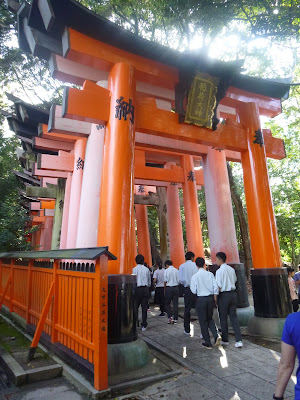Kyoto, Japan
After breakfast, we walked to the train to Fushimi Inari Shrine and Fukakusa Yabunouchicho
This is a Goshuin. Most Temples and Shrines, issue a Goshuin, this red stamp document. They are collected in a Goshuincho, translated as "Honorable Stamp/Seal Book." The basics are that they historically proof of attendance at a temple or shrine. The calligraphy is the date, the name of the shrine or temple, the words "奉拝 (houhai)" (which means to worship), and a stamp with the name of the shrine. The full story and an explanation of the seal's origins and collections can be found here. I collected several in my Honorable Book. Our friend Yuko added the post-a-notes so I would remember where they came from. The stamps were 300 yen each, and most are done while you wait and watch. Some sites had one calligrapher; the most I saw was six at one Temple.
An excellent reference for the manners expected at a shrine can be found here.
 |
| Young men on a school trip, performing the ritual cleansing before entering the temple |
Fushimi Inari is the most important of several thousands of shrines dedicated to Inari, the Shinto god of rice. Foxes are thought to be Inari's messengers, resulting in many fox statues across the shrine grounds. Fushimi Inari Shrine has ancient origins, predating the capital's move to Kyoto in 794.
 |
| The foxes have various things in their mouths. |
Flanking the entrance to temples. there are two figures associated with the temple. One will always have the mouth open and one the mouth closed.
This complex is known for its foxes
Then we took the train to the hotel and changed to walk to the
13 Okazaki Saishojicho, Sakyo Ward, Kyoto, 606-8342, Japan
Then across the street to the
The writer/director of the theatre piece has done a film included in the exhibition "Dress Code"

Then Off to a local Udon Noodle Shop
















No comments:
Post a Comment